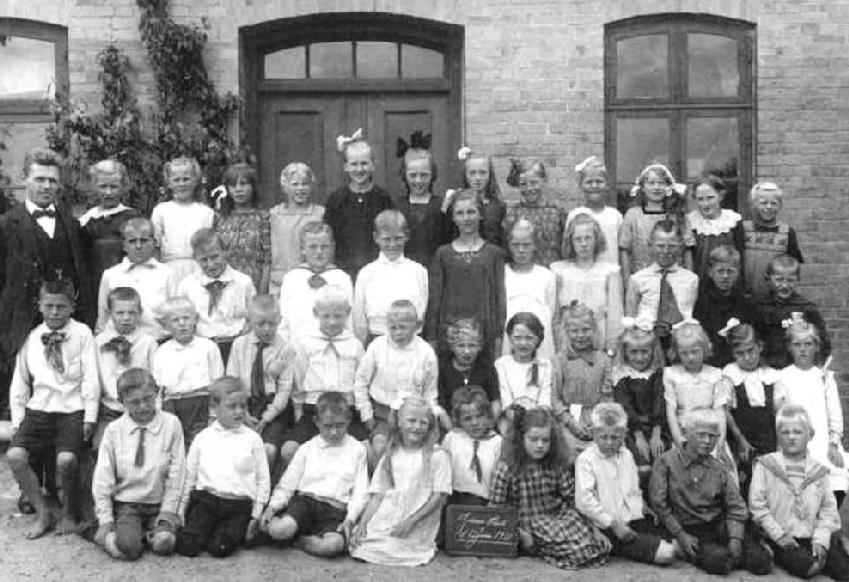
Individual Danish Schools

Figure 1.--Gram is a village in southern Denmark (Sønderjyllands County). Here we see the school in 1917. It must have been a nice warm day in the Spring or early summer and the way yhe children are dressed reflects this. The boys mostly wear blouses, a few with floppy bows. As in Germany, a few boys wearsailor suits. The girls wear dresses, but without pinafores.
|
|
Information on individual schools id very useful in developing an understanding of both fashion and education trends. At this time we have only limited informtion. We note an unidentified class portrait taken during World War II in 1943. Here we see the 3rd grade pupils of Østrigsgades Skole (i.e. Austria Street School) in 1955. It is a Danish school located in København (figure 1). It is a good example of boys' school clothing in the post-World War II era. Only one boy wears long trousers. Most of the boy are wearing collared shirts, but one boy wears a t-shirt. The boys wear shoes with and without socks and sandals with and without socks. Apparently boys a girls were still taught in different classes. We also have information from Gram which is a village in southern Denmark (Sønderjyllands County).
Here we see an Danish school class during 1943. The girls wear knee socks, long stockings, or anklets. The two boys in the front row wear short pants with knee socks and sweaters. The children seem happy, reflecting the relatively mild NAZI occupation of Denmark. Forlargely racial reasons, the NAZIs were not as brutal in Denmark as they were in many other countries, but it was still a very difficult period for the Danes.
We have a photo was taken at the primary school of Maarslet, or Mårslet, a village in Eastern Jutland (1919). This was right after World War I. Denmark remained neutral in the War, but was affected by bit economically. The boys wear mostly short pants or knee pants. Most of the boys are barefoot. The girls are probably also barefoot, but we can not see in the photograph. A few of the boys wear sailor suits. Several boys haves ties, but those who do not have buttoned their sdhirt collars. It is less clear what the girls are wearing, but they almost certainly are dresses. several of the girls wear pinfores. The clothing looks very similar to what children in Germany wore. The children look to be asbout 6-12 years of age. There are three teachers, a man who is presumably the principal and two ladies to teach the younger children.
Gram is a village in southern Denmark (Sønderjyllands County). Here we have two photos taken in the village school in 1917 and 1947. We see the school during World War I in 1917. It must have been a nice warm day in the Spring or early summer and the way yhe children are dressed reflects this. The The boys mostly wear blouses, a few with floppy bows (figure 1). As in Germany, a few boys wearsailor suits. The girls wear dresses, but without pinafores. We also see the school in 1947 after the World war II German occupation. It looks to have been a chilly day, but not yet winter. The boys wear jackets and sweatrs with both short pants and jnickers. The girls all wear dresses, spme with sweaters.
Here we see the 3rd grade pupils of Østrigsgades Skole (i.e. Austria Street School) in 1955. It is a Danish school located in København (figure 1). Tghere is a good view of the school in the background. It is a good example of boys' school clothing in the post-World War II era. Most of the boy are wearing collared shirts, many in bright prints. One boy wears a t-shirt. Only one boy wears long trousers. Most of the boy are wearing collared shirts, but one boy wears a t-shirt. The boys wear shoes with and without socks and sandals with and without socks. Apparently boys a girls were still taught in different classes. Note the male teacher and his casual dress.
HBC-SU

Related Chronolgy Pages in the Boys' Historical Web Site
[The 1880s]
[The 1890s]
[The 1900s]
[The 1910s]
[The 1920s]
[The 1930s]
[The 1940s]
[The 1930s]
[The 1940s]
[The 1950s]
[The 1960s]
[The 1970s]
[The 1980s]
Related Style Pages in the Boys' Historical Web Site
[Long pants suits]
[Knicker suits]
[Short pants suits]
[Socks]
[Eton suits]
[Jacket and trousers]
[Blazer]
[School sandals]
[School smocks]
[Sailor suits]
[Pinafores]
[Long stockings]
Navigate the Boys' Historical Clothing Web Page
[Return to the Main Danish school page]
[Return to the Main school uniform country page]
[Return to the Main Danish page]
[Introduction]
[Activities]
[Biographies]
[Chronology]
[Clothing styles]
[Countries]
[Topics]
[Bibliographies]
[Contributions]
[FAQs]
[Glossaries]
[Images]
[Registration]
[Tools]
[Boys' Clothing Home]
Created: 8:28 PM 4/11/2007
Last updated: 6:13 AM 2/8/2011




